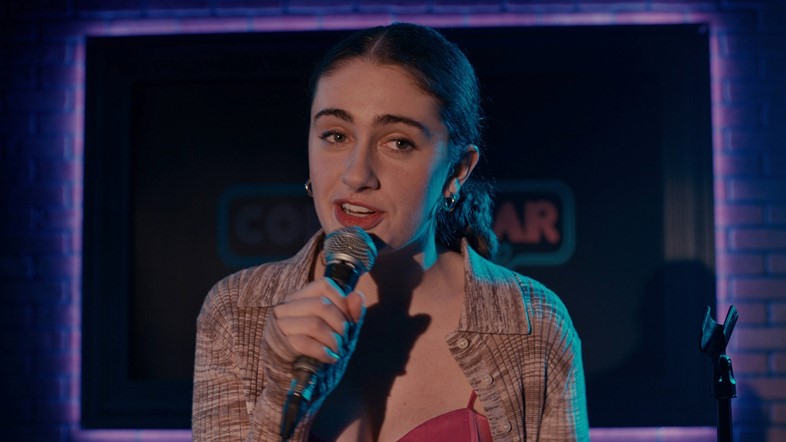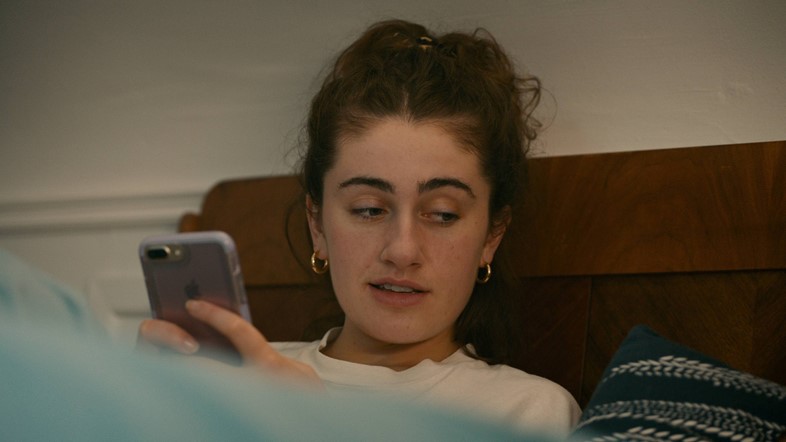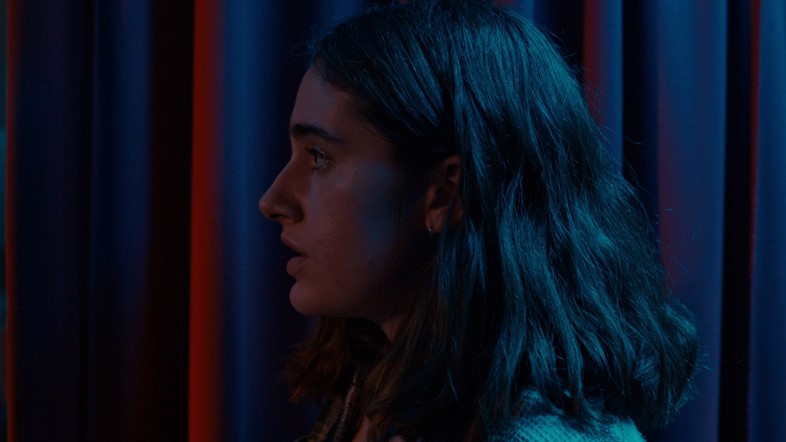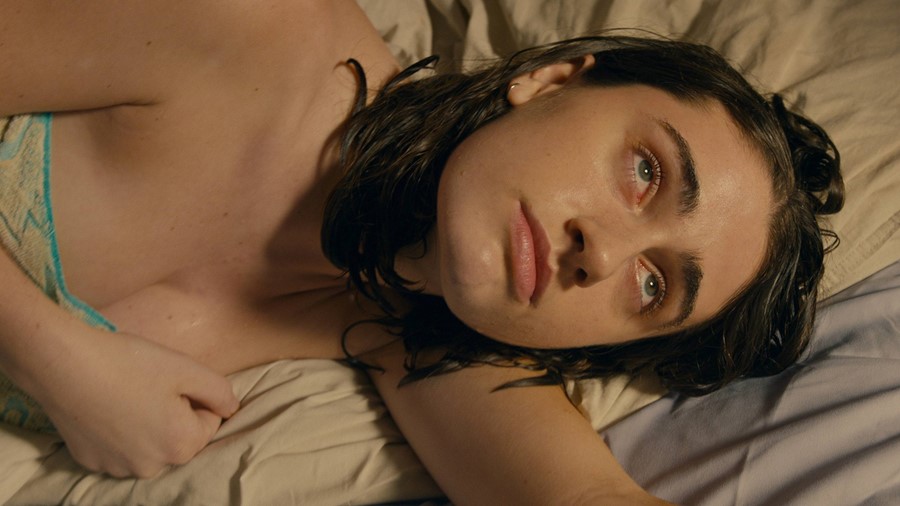As I Used to Be Funny is released, Rachel Sennott discusses playing a “traumatised but funny as hell” stand-up comedian struggling with PTSD, and the role of humour in dark times
For all the convenience technology promises, too often the intended benefit misfires and becomes an interference. As comedian-cum-au pair Sam in I Used to Be Funny, Canadian filmmaker Ally Pankiw’s feature debut, Rachel Sennott is asked to navigate one such episode when Brooke, the recently bereaved teenager she looks after, complains about her phone: every time she goes to take a picture, it summons a photo montage that exacerbates her grief. “The feature is horrible, and it adds songs. It’s not good,” concurs Sam, quickly diverting the conversation to Brooke’s selfie game. Tender and familiar, the scene is a deft summation of the film’s peculiar charms, marrying deep psychological trauma with sharp, Gen-Z-coded sarcasm.
Of course, sharp, Gen Z-coded sarcasm is what comes naturally to Sennott. “This is the Verizon commercial,” she types over text when a series of tech fails intrude on our Zoom call, her pained sentiment punctuated by a semi-ironic crying emoji. It’s a little after 10am in her LA office and, having just returned from the east coast, she’s been up since five, enthusiastically announcing she’s “ready to go” before a dodgy connection interrupts us. When the conversation resumes, via Facetime, the actress has swapped her standing desk for a treadmill that will be familiar to her fans on TikTok. “I can’t sit long, I get really jumpy,” she offers.
Away from social media – where her Twitter posts marked her as a distinctive new voice in American comedy – Sennott’s standout performances include a rich set of feature-length pictures like Shiva Baby, Bodies Bodies Bodies and Bottoms, the latter of which she co-wrote with Shiva Baby director Emma Seligman, and which coincidentally debuted in tandem with I Used to Be Funny at SXSW in 2023. She developed two series, Ayo and Rachel Are Single and Taking the Stage, with The Bear star Ayo Edebiri for Comedy Central, and more recently the actress played ringleader to Charli XCX’s ‘new hot internet girl’ posse in the iconic 360 video. Within hours of our call, the casting for her upcoming HBO pilot dropped online, with Jordan Firstman and Odessa A’Zion both set to star.

As Sam in I Used to Be Funny, Sennott is “traumatised but funny as hell” playing Brooke’s au pair of two years and an upcoming name on the Toronto comedy scene. Or she was: the film zigzags between the past and the present, with current-day Sam barely able to get out of bed owing to a wholly distressing event that’s disclosed in the film’s third act. “Ally sent me the script, I read it and loved it,” recalls the actress. “It was really beautiful, capturing the messy and nuanced way that trauma and PTSD express themselves. Then, talking to Ally, her vision was ‘I don't want to make it black and white, because it’s so much more complicated than that.’ I hadn’t seen that before, so I wanted to be part of it.”
Through its time-hopping structure, the film focuses on the very real notion that ‘healing’ is rarely, if ever, linear. Keenly rejecting the revenge trope, Sam – alongside her comedian housemates, played by Caleb Hearon and Sabrina Jalees – instead sits in this complex emotional state, cracking bleak one-liners about ACAB, SEO and, when Brooke disappears, her missing poster. “It’s a fine line, you don’t want to tread too much in one direction,” she notes of finding this balance. “Ally was my guiding light, but also a lot of humour for me comes from dark moments in my life – that’s when you have to be really funny and make yourself laugh. And then [on set], Caleb and Sabrina brought such joy and cracked me up. There’s this really funny photo, somewhere, of me sitting in the corner crying and they’re just in front laughing. It’s hilarious.”

On screen, Sam can just about make it to the green room of their local comedy club, while clips of her old self performing are interspersed throughout the film. “We crafted it so it felt personal to me and I could get into the rhythm of it,” explains Sennott, who road-tested the material IRL, signing up for shows in character as Sam. “I was still doing stand-up then, so it was cool to write these jokes that in some ways were close to my material but in other ways weren’t at all, and then go to Comedy Bar and call myself a different name. Someone actually came up to me after and was like, ‘You’re not Sam, you’re Rachel,’ and I was like, ‘No I know, we’re doing meta stand-up.’ It was really exciting.”
Music was another helpful tool, she observes, explaining that “Sam would listen to sad indie girl music – definitely Muna and Phoebe Bridgers.” Moreover, with a tight 18-day shoot schedule, a solid rehearsal period allowed her to comfortably immerse herself in the character, especially for the scenes with Olga Pesta, who plays Brooke. “Sam and Brooke’s relationship is so important, and getting to build that connection with Olga, who’s so sweet and super talented, before we jumped in was great,” says the actress. “You get your nerves out of the way and can try things, then on the day you’re so flexible and free, but you have a plan.”

Reflecting on her own personal highlights from making the movie, Sennott cites a couple of scenes underscoring where Sam is at by the closing credits: “The bit where I’m talking about how I don’t feel funny any more and my life is fucked up – that was such an expression of what Sam has been bottling up the entire movie, you know? So that felt cathartic. And then going to Niagara Falls, that was gorgeous! We actually shot that after the movie, we were talking about the ending like, ‘We need a moment, a release,’ and Ally was like, ‘We have to go to Niagara Falls.’ When you’re finishing a movie the end is always hectic, so going back and shooting that, it felt like a celebration of the project. I love that it’s in the movie.”
I Used to Be Funny is out in UK cinemas now.
